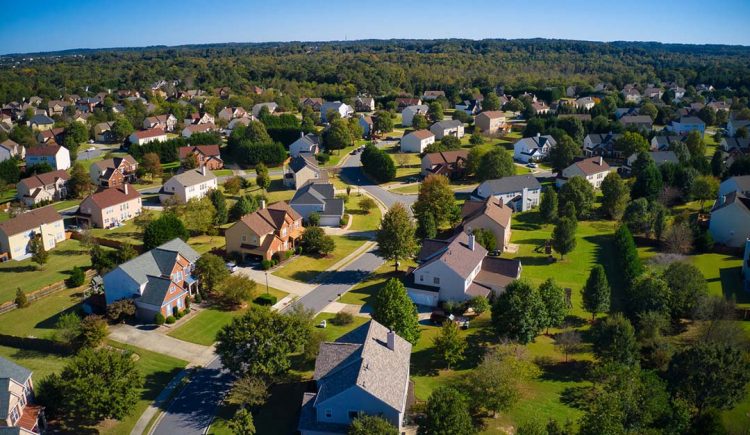Prices for single-family homes heated up even more as the summer market kicked off in June, according to the most recent S&P CoreLogic / Case-Shiller Indices.
For the third consecutive month, home prices saw record growth with an 18.6% uptick in June—up from 16.8% in May. Experts note that marks the highest reading in more than 30 years of S&P CoreLogic Case-Shiller data.
All 20 cities saw higher annual price increases as the 10-City Composite increased 18.5%, while the 20-City Composite increased 19.1%.
Phoenix, San Diego and Seattle marked their 25th month as top-three markets with the highest gains, recording increases of 29.3%, 27.1% and 25.0%, respectively.
The complete data for the 20 markets measured by S&P:
Atlanta, Ga.
June/May: 2.5%
Year-Over-Year: 16.5%
Boston, Mass.
June/May: 1.3%
Year-Over-Year: 18.6%
Charlotte, N.C.
June/May: 2.6%
Year-Over-Year: 19.0%
Chicago, Ill.
June/May: 1.9%
Year-Over-Year: 13.3%
Cleveland, Ohio
June/May: 1.7%
Year-Over-Year: 15.4%
Dallas, Texas
June/May: 3.0%
Year-Over-Year: 21.3%
Denver, Colo.
June/May: 2.4%
Year-Over-Year: 19.6%
Detroit, Mich.
June/May: 2.3%
Year-Over-Year: 16.3%
Las Vegas, Nev.
June/May: 3.4%
Year-Over-Year: 19.8%
Los Angeles, Calif.
June/May: 1.9%
Year-Over-Year: 18.7%
Miami, Fla.
June/May: 3.0%
Year-Over-Year: 20.1%
Minneapolis, Minn.
June/May: 1.8%
Over-Year: 13.8%
New York, N.Y.
June/May: 0.8%
Year-Over-Year: 16.7%
Phoenix, Ariz.
June/May: 3.6%
Year-Over-Year: 29.3%
Portland, Ore.
June/May: 2.2%
Year-Over-Year: 19.2%
San Diego, Calif.
June/May: 2.6%
Year-Over-Year: 27.1%
San Francisco, Calif.
June/May: 2.6%
Year-Over-Year: 21.9%
Seattle, Wash.
June/May: 1.5%
Year-Over-Year: 25.0%
Tampa, Fla.
June/May: 3.0%
Year-Over-Year: 21.5%
Washington, D.C.
June/May: 1.7%
Year-Over-Year: 16.1%
What the Industry Is Saying:
“The last several months have been extraordinary not only in the level of price gains but in the consistency of gains across the country. In June, all 20 cities rose, and all 20 gained more in the 12 months ended in June than they had gained in the 12 months ended in May. Home prices in 19 of our 20 cities—all but Chicago—now stand at all-time highs, as do the National Composite and both the 10- and 20-City indices.
“June’s 18.6% price gain for the National Composite is the highest reading in more than 30 years of S&P CoreLogic Case-Shiller data. This month, Boston joined Charlotte, Cleveland, Dallas, Denver and Seattle in recording their all-time highest 12-month gains. Price gains in all 20 cities were in the top quartile of historical performance; in 19 cities, price gains were in the top decile.
“We have previously suggested that the strength in the U.S. housing market is being driven in part by the reaction to the COVID pandemic, as potential buyers move from urban apartments to suburban homes. June’s data are consistent with this hypothesis. This demand surge may simply represent an acceleration of purchases that would have occurred anyway over the next several years. Alternatively, there may have been a secular change in locational preferences, leading to a permanent shift in the demand curve for housing. More time and data will be required to analyze this question.” — Craig J. Lazzara, Managing Director and Global Head of Index Investment Strategy at S&P Dow Jones Indices
“Today’s S&P Case Shiller Index spotlights a hot summer’s housing market, where buyers prepared with cash for down payments and low-interest rate loans placed competing bids for an evaporating supply of homes available for sale and drove further record-high price growth. July saw mortgage rates drop 20 basis points, which gave buyers an additional edge in the pursuit to find their first or next home.
“Rising prices during summer months reflect a combination of peak demand and larger homes for sale, as families with school-age children competed to secure a place for the new school year. In a noticeable shift, July also saw real estate markets welcome a larger influx of new listings as homeowners across the country decided to move on with pandemic-delayed plans to sell. Based on realtor.com®’s weekly data, the inventory boost has already taken the sting out of the steep price gains seen during the first six months of this year, indicating that the overheated appreciation pace is behind us.
“For first-time homebuyers, the latest housing trends hold promise for more housing options, less competition and more approachable home prices in the second half of 2021. With financing costs still at historically low levels, the fall and winter months could provide reprieve for many buyers who may have grown fatigued by this year’s intense competition.” — George Ratiu, Senior Economist, realtor.com®
Jordan Grice is RISMedia’s associate content editor. Email him your real estate news to jgrice@rismedia.com.












